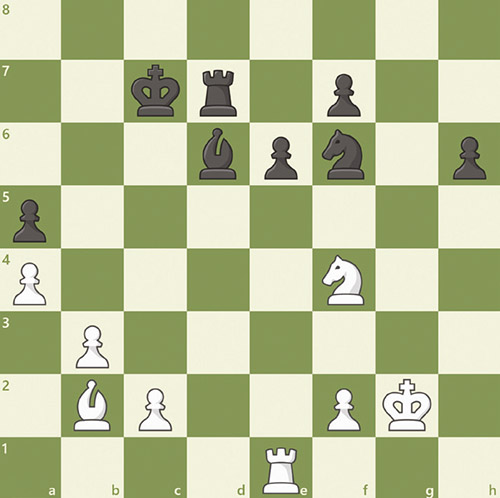
In chess, a desperado is when a piece that is going to be lost captures an opponent’s piece before it is captured to win back some material. The concept is demonstrated in Figure 1 where both knights are attacked by the opposing side’s dark squared bishop. If white simply captures the black knight on f6, black will capture the knight on f4 and material is equally exchanged. Instead, white attains a winning advantage by playing the desperado knight takes e6 check, sacrificing the knight for the e6 pawn. After black captures the knight on e6 with the f pawn, white then takes the f6 knight and black cannot even prevent white from winning the e6 pawn as well. At the end of the sequence white is left up two pawns in a completely winning endgame.
The position displayed in Figure 2 is from a game played between Grandmasters Magnus Carlen with the white pieces and Levon Aronian with black from the 2008 Morelia-Linares. Magnus began with 1. Nd5, attacking pinned black’s knight on f6. Levon first responded with 1 … Rg8+ 2. Kf1 Ng4, sacrificing his queen on d8 with the threat of going Nh2# checkmate. If white captures the g4 knight, Levon is completely winning after Qxh4, so Magnus instead played the desperado 3. Qxd4+. This is the only winning move as it sacrifices the queen for the d4 knight with check so that the h4 bishop can then capture the d8 queen; Nh2+ is no longer checkmate as the king can now escape to e2. 3 … Bxd4 4. Bxd8 Nh2+ 5. Ke2 Raxd8 and black ends up a pawn but the h2 knight is stranded on the edge of the board with no squares to escape to.

However, if Magnus immediately attacks the knight with Rh1, Levon can play Rg2, both defending the knight and threatening to take the f2 pawn. Therefore, he first went 6. Rad1 Bxb2 to force the bishop away from targeting f2; if black moves the bishop back to a7, white has Nf4 to prevent Rg2. 7. Rh1 and Levon continued by counter-attacking the d5 knight with 7… c6 8. Nf4 Be5 but white can simply move out of the threat with 9. Nd3 and the black knight on h2 is lost. Rg2 to defend the knight it is parried with Nxe5 and black cannot capture back because the d6 pawn is pinned to the d8 rook. Therefore, Levon also employed the concept of a desperado with 9 … Nxf3, at least gaining a pawn as compensation for the unsavable knight. 10. Kxf3 Bg7 and Magnus went on to win the game with his advantage of an extra knight for three pawns.
Figure 3 is from a game at the 2009 Aeroflot Open between Grandmasters Shakhriyar Mamedyarov with white and Igor Kurnosov with black. The game actually has an interesting backstory as Mamedyarov accused Kurnosov of cheating and withdrew from the tournament. In the position displayed in Figure 3, material is equal but highly tactical with the black knight and both queens hanging. To win the contested game, Kurnosov played the desperado sacrifice queen to d2, which moves the queen from f4 where it is hit by the knight to d2 where it faces the d4 rook and threatens checkmate on b2. The rook is forced to capture the queen after which black has knight takes d2 check, forcing the white king to move, ideally to c1. Black then captures the white queen on h5 with the bishop and, whether white takes the h5 bishop or the d2 knight, black ends up an exchange with a winning position.
The position shown in Figure 4 is from a game between Borislav Kostic with white and Heinrich Wolf with black from the 1922 Teplitz-Schönau. Black is up a bishop for a pawn but white wins the game with the sacrifice queen takes h7, which the rook cannot capture because white would then have knight take e8, forking the black queen and king and ultimately winning a rook. Therefore, Wolf moved the king back to f8, but white is still winning because the desperado knight takes e8 anyway. If the rook captures the white queen on h7, then the knight can capture the black queen on c7, and if the king takes the knight on e8, the white queen can escape to g7 with a strong attack ready against the black king and a material advantage.

Ethan Feder is a junior at Yeshivat Frisch, a chess enthusiast and player. The goal of his column is to teach and discuss chess concepts through example positions, high-level games and relevant puzzles, along with explanations. Feel free to contact him with any questions, suggestions or comments at ethan.feder@gmail.com.












